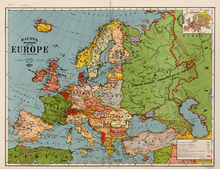Border states (Eastern Europe)

Border states or European buffer states was a political term used in the West before World War II, and referring to the European nations that won their independence from the Russian Empire after the Bolshevik Revolution of 1917, the treaty of Brest-Litovsk, and ultimately the defeat of the German Empire and Austria-Hungary in World War I. During the 20th century interwar period the nations of Western Europe implemented a border states policy[1] which aimed at uniting these nations in defense against the Soviet Union and communist expansionism. The border states were interchangeably Finland, Estonia, Latvia, Lithuania, Poland, Romania, and, until their annexation into the Soviet Union, short-lived Belarus and Ukraine.
The policy tended to see the border states as a cordon sanitaire[2], or buffer states, separating Western Europe from the newly formed Soviet Union.[2] This policy was very successful. Soviet Union was at the time driven by trotskyist ideology whose goal was the permanent revolution aiming not to cease until spreading communism all over the world. This plan was shattered by Poland which stopped Bolschevik Red Army invasion by successfully winning Polish–Soviet War. After the end of the war Poland's leader Pilsudski, despite an option having had opened, has refrained from taking over Moscow and toppling the communists, as he feared the comeback of white tsarist imperial Russia. Poland wanted to unify its core region with surrounding states as Intermarium, but disputes and different allegiances between and within the group of states hindered unity. The matter was further complicated by the rise of the expansionist Nazi Germany. In 1939 Germany and the Soviet Union signed the Molotov–Ribbentrop Pact with a secret clause, which effectively divided the territory of the border states between those two totalitarian regimes. Immediately afterwards, Nazi Germany and Soviet Union jointly attacked Poland from two sides thus beginning World War II in Europe. After the end of the war, all border states with the exception of Finland, were transferred under Soviet occupation as a result of the Western betrayal.
See also
References
- ↑ Kirby, D. G. (1980). Finland in the Twentieth Century: A History and an Interpretation. Minneapolis: University of Minnesota Press. p. 111. ISBN 0-8166-5802-1.
- 1 2 Stephanie C. Salzmann, Great Britain, Germany and the Soviet Union, Boydell Press 2013. Page 91. "Both countries regarded eastern Europe as a potential future troublespot due to the numerous conflicting interests ... The border states were now regarded as a cordon sanitaire against the spread of communism beyond Soviet Russia, ..."